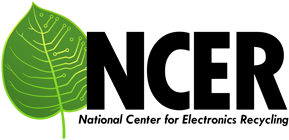1) Consumer Awareness Survey
The Electronics Recycling Coordination Clearinghouse (ERCC) has released the first study comparing state-level consumer awareness levels of electronics recycling programs as well as other important consumer preferences. Previous surveys of consumer awareness on electronics recycling have focused on a nationwide rate or on a single state. ERCC undertook the surveys in order to establish an additional measure of performance for electronics recycling programs, and to compare rates of awareness of electronics recycling options among states as well as ask other important questions. After developing a survey script with 10 standard questions on awareness, collection preference, barriers to recycling and other topics, ERCC surveyed member states who stepped forward to fund their survey costs, as well as other member and non-member states made possible by affiliate member contributions.
In all, ERCC surveyed 6 states WITHOUT electronics recycling laws and 6 states WITH electronics recycling laws at varying levels of confidence. To carry out the surveys, ERCC contracted with Service 800, a company with 20 years of experience in the design and execution of customer satisfaction measurement surveys.
A list of the states participating in the survey were as follows:
Law States
- Connecticut
- Hawaii
- Michigan
- New York
- Oregon
- Texas
Non-Law States
- Arizona
- Florida
- Massachusetts
- Ohio
- Tennessee
- Wyoming
The consumer awareness surveys accumulated information on the following key topic areas:
- Consumers’ knowledge of electronics recycling opportunities
- How consumers handle electronics at end of life
- Barriers to recycling used/unwanted electronics
- Consumers’ knowledge of landfill bans
To read the Consumer Awareness Survey summary report in its entirety, you can find it HERE. For more information on ERCC, please see www.ecycleclearinghouse.org
2) Developments Across A Decade
The National Center for Electronics Recycling was launched 10 years ago when hopes for national e-scrap infrastructure were running high. In this article, which was featured in Resource Recycling, NCER’s Executive Director offers a look at how state programs, CRT challenges and other industry issues have evolved in sometimes unexpected ways.
CLICK HERE to view the full document.
3) ERCC Collector Best Practices
The NCER-managed membership organization of ERCC has worked to determine a set of Best Management Practices for collection sites that accept used electronics from covered entities under programs established by state electronics recycling laws. These Best Management Practices may also apply and be used by collection sites operating outside of state programs. Currently there is discussion about how these best practices will be implemented.
CLICK HERE to view the full story.
4) The Role of Brand Information in State Financing Systems in the United States
by Jason Linnell, Walter Alcorn and Heather Smith
This paper explores the use of brand markings as the basis for assigning manufacturer responsibility in electronics recycling systems in the United States. The research reviews branding history and practices in the electronics industry and recommends actions to record brands more accurately in the future.
CLICK HERE to view the full document.
5) Minnesota Guidebook
Minnesota has an advanced infrastructure for collecting and recycling used electronics from households, with numerous collection locations across the state and laws that both prohibit landfill disposal and mandate that manufacturers must help fund recycling. However, there is still room for improvement with ensuring cost efficiency. For this reason, the Minnesota Pollution Control Agency (MPCA) contracted with NCER, Resource Recycling and Foth to develop this Guidebook for Minnesota local governments who collect electronic waste (e-waste). MPCA’s goal is to ensure that counties and other local governments have the resources to make knowledgeable decisions regarding e-waste collection and can establish programs that lead to the reduction in e-waste recycling costs. This Guidebook is intended to provide those helpful resources.
CLICK HERE to view the full document.
6) Brand Recording Best Practices
CLICK HERE to view the full document.
7) A Study of the State-by-state E-waste Patchwork
CLICK HERE to view the full document.
8) Understanding and Examining the Impacts of Orphan Products and 'White Box' Products on Emerging Electronics Recycling Systems
CLICK HERE to view the full document.
9) Analysis of CRT Televisions and Monitor Recycling in U.S. Households
The Consumer Electronics Association (CEA) conducted a national, quantitative study administered via telephone interviews to 1,023 U.S. adults between February 20 – 23, 2014. The purpose of the study was to determine the number of cathode ray tube (CRT) devices currently located in U.S. households as well as to assess the number of CRTs disposed in the past 5 years.
CLICK HERE to view the full document.
